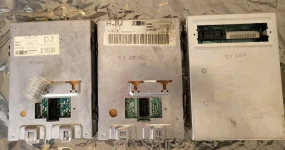68K/SuperH still lives on in cars and industrial applications. There is a push for ARM now - ST and Freescale/NXP are leading that. HMI - including UX and self-driving/ADAS needs more powerful processors. Nvidia, Intel and AMD are making a big play there - Tesla is using AMD Zen architecture APUs(CPU + GPU + AI accelerator), VW’s using Nvidia Tegra SoCs in Audis. 68K is 16-bit, Toyota states their PCMs are 32-bit.
The Intel 8088/8086 was very popular in cars as well. Even Hitachi, NEC and Oki made clones of it for the Japanese OES(Hitachi’s own Unisia JECS which was a JV with Bosch, Denso - also using Bosch licenses and Keihin for Honda).
The Intel 8088/8086 was very popular in cars as well. Even Hitachi, NEC and Oki made clones of it for the Japanese OES(Hitachi’s own Unisia JECS which was a JV with Bosch, Denso - also using Bosch licenses and Keihin for Honda).

